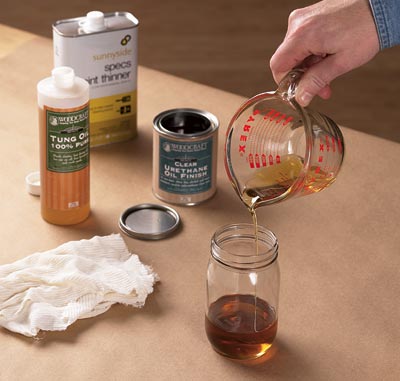There’s an old Vaudeville line that goes something like this:
A man is not complete until he is married. Then, he’s finished.
I remember chuckling when I first heard that, and the hurt look on my wife’s face when I told her for the first time. That one took a lot of flowers and a homemade dinner to make up for.
For years, when I first started woodworking, I had a similar expression I used to tell everyone:
Finishing is the easiest way to ruin a perfectly good woodworking project.

I hated finishing a piece. It never failed – I had my finishing regimen, and it was always a disaster.
First, I would sand the piece. I don’t like to sand, and all I owned was a ¼ sheet finishing sander. Do you know how long it takes to sand saw marks out of a piece of wood with one of those? I’m asking because I just don’t know – I would always stop sanding WAY before the surface was smooth. I’d run the sander, step back (eyes watering from sawdust) and say, “OK, that’s enough for me.”
Then, I would stain my project. Since my first pieces were made of the cheapest wood I could buy, that meant pine. No. 2 common from the local home center. And, if you have ever tried to stain pine, you know that you should expect the worst. The blotching was incredible.
Impatient, I would never wait the recommended time for the stain to dry. I would pick up the can of brush-on poly and proceed to slop the stuff on with the first brush I could find that wasn’t totally clotted up with old, dry paint.
Needless to say, the pieces were always a disaster. Machining marks, blotchy stain and sags and runs in the finish were always hallmarks of my pieces. Oh, and the finish was very rough to the touch, what with all the dust in the film. It was pretty nasty.
After ruining several projects, I just had to find a new way to do things. After reading some great books – notably Bob Flexner’s Understanding Wood Finishes – and posting lots of questions on woodworking message boards, I was turned on to a method I use with great success. Maryland box maker Dave Knipfer calls it the Rude and Crude method of finishing, and I’ve found that there’s a lot of sound wisdom in giving it a shot.
First, I’ve really done away with staining. When I need a piece of wood to look like cherry – I go and get cherry. The range of colors in domestic and exotic hardwoods – and softwoods, for that matter – is very impressive. I’ve found it easier – and gives a better result – if you let the wood’s natural color come through.
The next thing I did was improve my sanding technique. Now, I’ll use a smoothing plane and scrapers to do the bulk of the work, and I will use sandpaper wrapped around formed bocks to reach into molding profiles. My Porter Cable random orbit sander does occasionally make an appearance, but the sweet action of planes and scrapers eliminates the drudgery of sanding.
The next thing I do is to use Zinnser Seal Coat as a sanding sealer. It’s a 2# cut of clear, dewaxed shellac, and I usually cut it half and half with denatured alcohol to ensure a very light coat. I’ll blow off any dust on the piece and then use a rag to wipe the shellac on. Don’t be bashful, use a lot of it!
Once it’s all covered, then you set the project aside for the shellac to dry. Give this process at least two hours for the shellac to really get set – overnight is preferable.
This next step may seem kind of counter-intuitive, but bear with me. You want to use a fine grit sandpaper (320 or higher), #0000 steel wool or a fine plastic abrasive pad, and rub the shellac finish. You want to sand that surface for a good long time. Dave says to rub until your arm is about to fall off – if your sanding arm hurts after a few minutes, you are doing a good job!
What you are doing is removing all of the shellac from the surface, leaving only the stuff down in the pores. Remember the blotchy pine problem? Leaving this shellac seal coat in the pores will eliminate it once and for all.
After what seems like an eternity, you’ll have a very smooth, begging to be touched surface on your project.At this point, I blow the dust off of the piece and get ready for the final step.
I have given up on brushes. Period. My new motto is, “If I can’t wipe it on, I don’t use it.” Wipe on polyurethane, varnish, Danish oils or similar finishes go on beautifully in very thin, even coats. You would have to try really hard to leave a wipe mark, sag or other imperfection in the surface if you use these products. The finish goes on very smooth over the prepared surface, and I set the piece aside to dry. Later, I will put on additional coats of the finish, following the manufacturer’s directions.
What do my projects look like now? The wood absolutely glows under a picture perfect finish. People who look at my stuff want to see it first, and then they want to touch it.
It’s a finish fit for a king.
Here King!



 The band saw is one of the most versatile tools in the shop. It can cut curves, rip, crosscut, resaw and cut in 3-D… but, only if it’s tuned properly!
The band saw is one of the most versatile tools in the shop. It can cut curves, rip, crosscut, resaw and cut in 3-D… but, only if it’s tuned properly!